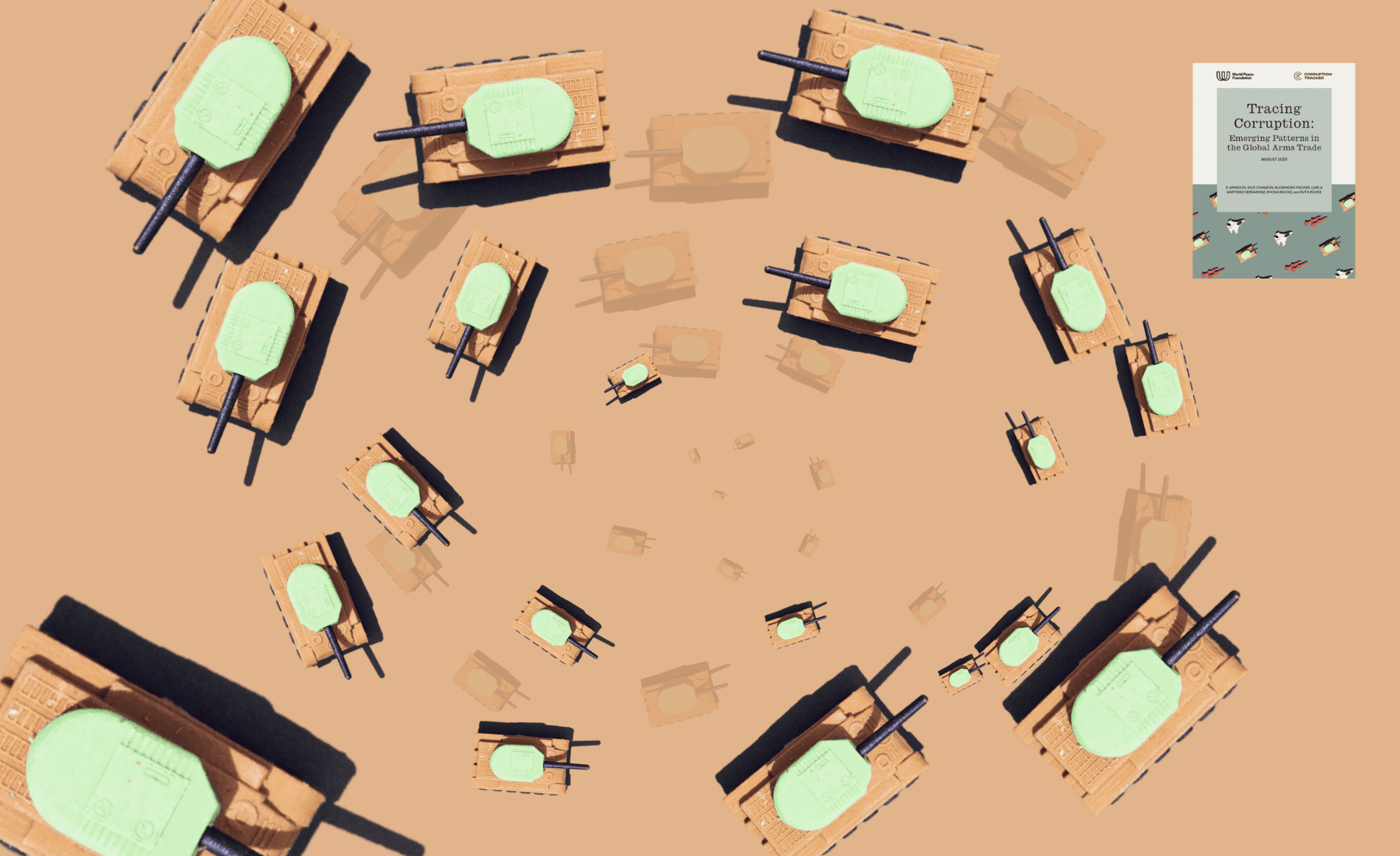The below is an excerpt from our new report, “Tracing Corruption: Emerging Patterns in the Global Arms Trade” (World Peace Foundation and the Corruption Tracker, August 2025).
The proposed increases in defense spending across Western Europe, and indeed in many countries worldwide, in reaction to Russia’s invasion of Ukraine are likely to be interpreted by the arms industry as a de facto blank cheque. The rapid influx of funding, in the absence of stringent regulation, effectively invites the industry to raise its prices, which will only result in further price inflation and wasteful spending.
At the Corruption Tracker, we have documented numerous high-profile and more obscure cases, where the arms trade has been plagued by price inflation and wasteful spending, all at great expense to the public. For example, the sustainment contracts awarded to Thales and BAE Systems’ Australian subsidiaries for the maintenance of the now-decommissioned Adelaide-class frigates exemplify a troubling pattern of financial mismanagement and cost inflation in the arms trade. In total, the maintenance of the frigates has cost the Australian Department of Defence (DoD) a suspected AUD $170 million, up from AUD $72 million. The Australian DoD’s internal evaluation reportedly found that BAE’s Adelaide contract was “riddled with cost overruns, with the British company consistently invoicing questionable charges.” These contracts alone accounted for an estimated AUD $79 million in unnecessary expenditure. Yet, this case is far from an anomaly.
The conditions of the arms trade create an environment where financial oversight is limited and opportunities for cost manipulation and price gouging are rife. What often goes unaddressed is how this climate of price inflation and lax monetary governance provides procurement officials and intermediaries with both the opportunity and the excuse to engage in corruption. When top-level government departments legitimize these behaviors, it fosters the social norms environment explored in the previous section. It is unsurprising that the USA, as the largest exporter in weaponry across the world, accounting for 43% of global arms exports, suffers from huge financial mismanagement and losses on its arms procurement. In fact, the Pentagon has failed its seventh audit in a row. This level of financial mismanagement forms the environment that creates endless opportunities for financial exploitation.
By analyzing six key cases in the CT database, we expose the projects through which public funds are misused and demonstrate how these practices foster a broader culture of corruption in the global arms trade.[i] Understanding these patterns is crucial for holding arms companies accountable and ensuring greater transparency in military spending. On the rare occasion that arms trade corruption finds its way into public discourse, the focus is generally headline-grabbing scandals. Even less attention is paid to how the routine inflation of military expenses, from advanced weapons systems to basic supplies, lays the groundwork for systemic bribery and financial abuse on a global scale.
In the following section, we examine how seemingly minor instances of price gouging can accumulate into substantial costs in major arms trade projects, costs that are often squandered on ventures that either collapse entirely or persist despite offering little in strategic value.
Price Gouging
Price gouging is a growing issue within the arms trade and the examples are vast. It is a persistent feature that often goes unpunished and receives minimal, if any, government oversight. The arms industry is small and highly consolidated, with government procurement departments frequently locked into sole-source contracts with a limited number of suppliers. This arrangement grants these companies the freedom to set whatever prices they wish. While price gouging is not a new phenomenon, recent cases highlight how deeply entrenched this practice remains. Take the US Pentagon as a case in point.
During the 1980s, the Pentagon became infamous for egregious overspending, such as $640 for a toilet seat, $7,600 for a coffee pot, and $436 for a hammer. But more recent examples are equally if not more shocking. For example, TransDigm charged $71.01 for a 4-cent metal pin, a staggering 177,000% markup; and other cases include $4,000 for a soap dispenser on Air Force planes, $52,000 for a trash can, and $90,000 for a bag of bolts normally priced at $100. According to Senator Chuck Grassley, the Air Force spent $32,000 to replace just 25 cups. However, one of the more shocking examples is the Air Force’s $23.7 million contract to replace two refrigerators on an Airforce One (the presidential fleet).
These examples illustrate a systemic issue where arms companies exploit their market dominance to extract excessive profits. This could be interpreted as legalized bribery, siphoning huge amounts of unaccounted funds from the taxpayer to the shareholders of arms companies. Yet, these are smaller, more conventional items rather than actual weapons, the everyday products with familiar price points that the general public can easily compare. In contrast, most people cannot compare the costs of advanced weaponry because such items are not part of everyday life or civilian purchases.
Big Projects
The issue of price inflation of course extends to the weapons, not only small and light weapons, but also the big projects, including all their components. Large-scale military programs are particularly vulnerable, with subcontractors further driving up expenses through inflated bids and hidden fees at multiple stages of the supply chain. This escalating trend of overpricing is especially evident in high-profile arms acquisitions.
In Australia, for example, the AUKUS trilateral security partnership, short for Australia, the United Kingdom, and the United States, is projected to cost approximately AUD$368 billion by 2050. As part of AUKUS, Australia would be obliged to purchase up to eight nuclear-powered submarines. Prior to this, the Australian government terminated a €56 billion contract it already held with France for conventional submarines, incurring a €555 million penalty to Naval Group, a huge amount of money wasted. Similarly, the Hunter-class frigate program, in which the Australian government would purchase multiple frigates from BAE Systems, has faced scrutiny for its soaring costs leaping from initial agreement of AUD $35 billion to $65 billion. These large projects are not isolated instances, but they reflect a broader pattern where the defense sector capitalizes on weak oversight to inflate prices continuously. As an example, the CT database includes at least 14 similar cases, including Tanzania’s Air Traffic Control System, The Indonesian AW101 Helicopter Deal, and Missing Mortar Rounds in Ukraine.
This phenomenon is further exacerbated by what can be described as “forever costs.” Modern military equipment, especially those integrated with advanced software systems like drones, often requires continuous updates and maintenance. Larger units, such as fighter jets, naval vessels, and land vehicles require a constant stream of spare parts, maintenance, as well as training, sustainment, and operating personnel. These long-term obligations add to the financial burden, ensuring that the costs of large-scale defense programs extend indefinitely.
The most notorious example being the Lockheed Martin F-35 fighter jet, the most expensive weapons program in history. The cost of the F-35 program, which has now been extended to 2088, is expected to have a lifetime cost topping $2 trillion, this includes $1.6 trillion in sustainment costs and $442 billion in acquisitions (as of April 2024). This is a total cost equivalent comparable to the annual national budget of Germany, the largest economy in Europe. Not to mention that Lockheed Martin decided on a $30 million settlement with the Department of Justice for massively inflating prices in relation to the F-35 program. These cost overruns are not a rarity in the arms industry, but are a commonality; another US program being the production for a new generation of nuclear intercontinental ballistic missiles (ICBMs), currently projected to surpass nearly $141 billion, 81 percent over the 2020 program budget ($214,000,000 per missile). The prioritization of these expensive military acquisitions diverts funds from investments in critical public services and infrastructure, and channels them into the pockets of arms company shareholders. This blatant misuse of funds not only undermines broader national development goals, but also leaves us, the general taxpayer, bearing the cost.
Many of these larger projects are embedded with corruption more narrowly defined. Take for example, Taiwan’s Lafayette Frigate and Mirage Scandal, one of the largest naval contracting corruption schemes in modern history. Not only was there approximately $520 million in kickbacks distributed to high-ranking officials in Taiwan, France and mainland China, but the contracts covering the purchase of 6 frigates and 60 jet fighters from France was also hugely inflated, from 10 billion Francs to 15 billion (USD 2 billion, although the contract was eventually USD 2.8 billion). Notably, there were eight suspicious deaths in relation to the case. These included members of the Taiwanese team who had inspected the frigates in France or were familiar with the contract clauses, as well as personnel from Thomson-CSF’s Japan branch involved in negotiating the terms. Among them was also a French intelligence agent who fell to his death from a window just one day before a scheduled meeting with a journalist. The pattern of these deaths has long fueled suspicions of an alleged cover-up involving massive kickbacks and corruption surrounding the deal.
Between 2011 and 2019, the US contributed almost $240 million to Niger’s military budget as they went on a military spending spree that totaled about $1 billion. However, according to the Inspection Générale’s auditors, more than $137 million had been lost to corruption, over-invoicing and wasteful spending. They sourced a good deal of equipment from Russian, Ukrainian and Chinese state-runs arms companies. Key figures within Niger’s ruling party at the time effectively hijacked the country’s defense budget, seizing the opportunity, just as so often happens in military procurement, to enrich themselves at the nation’s expense.
It must be noted that arguably all of the arms deals that involve corruption in monetary value will involve cost inflation, if not just inflating the prices in price gouging, then in covering the costs of bribes and kickbacks.
Beyond the financial implications, the environment of inflated costs and limited transparency constitutes a form of legalized bribery (corruption in plain sight), while also creating fertile ground for illicit corruption and quid pro quo arrangements. Relaxed financial oversight and normalization of excessive spending give procurement officials and intermediaries the means and justification to engage in illicit practices.
Uselessness
The arms trade is a profit-driven industry sustained by uselessness: waste, corruption, and complicit institutions. Military procurement failures are not isolated incidents but systemic features of an industry where inefficiency, obsolescence, and corruption are structurally embedded in a self-fulfilling prophecy that perpetuates insecurity.
The pattern of uselessness suggests a fundamental paradox: defense budgets may be driven less by strategic necessity and more by an economic imperative to sustain insecurity. Procurement cycles and manufactured threats justify endless financial flows, embedding waste and obsolescence as fundamental components of the system. National security is not compromised by inefficiency, but rather it is built upon it, transforming war into a self-sustaining market where failure is not a flaw but a lucrative opportunity. Conflict and fear seem to become an asset, ensuring a continuous demand for weapons, technologies, and contracts that point to serve profit over purpose.
A closer examination of major failed military programs exposes how institutional complacency and financial self-interest drive systemic waste.
The US Army’s cancellation of the Future Attack Reconnaissance Aircraft (FARA) in 2024 is a prime example of how entire military programs become obsolete before deployment, yet still absorb billions in taxpayer funds. After a $2.4 billion investment, the program was scrapped due to the growing role of drones in modern warfare, raising the question: why was such an outdated concept pursued for years? The answer lies in the procurement cycle itself, this is secure long-term funding, when obsolescence becomes undeniable, programs are quietly abandoned without financial repercussions for those involved. This pattern mirrors the infamous VH-71 Presidential Helicopter program, awarded to Lockheed Martin in 2004, whose costs ballooned from $4 billion to $13 billion before it was canceled in 2009, after approximately $4.4 billion had been spent and nine aircraft delivered. Despite this, Lockheed Martin and other contractors continued to secure lucrative defense contracts, reinforcing how the industry rewards failure. From skyrocketing costs that far exceed initial estimates to exorbitant maintenance expenses for equipment that has never even been tested, wasteful spending is a recurring issue.
The recycling of defective military equipment further exemplifies how inefficiency is monetized. No case highlights this more than the sale of Leonardo helicopters by Italy and the United Kingdom, first to India accompanied by a series of bribe payments before being deemed unfit by the Indian government (unable to fly at altitude over the Himalayas). This very same helicopter was then resold to Indonesia, again accompanied by a series of bribes, where they have remained unused in a hangar ever since, incurring high maintenance costs despite never having flown a single mission. Similarly, the US Navy’s DDG-1000 Zumwalt-class destroyer program highlights how budgetary excess leads to inefficiency and abandonment. Initially planned for 32 units, the program consumed an astonishing $23.5 billion before being cut to just three ships, each suffering from technical failures and requiring additional costly modifications. Yet, despite this clear financial mismanagement, arms companies reaped immense profits from development and testing phases.
This was far from an isolated case: major budgets allocated to failed or inactive projects are plural. Take the UK’s Ajax Armored Vehicle program, which saw over £5.5 billion spent without producing a single working vehicle. Or Saudi Arabia’s purchase of 72 Eurofighter Typhoons, with many jets still being grounded due to maintenance and training issues, with speculation that they will be replaced by F-35s. Or Germany’s Puma Infantry Fighting Vehicle, developed at a cost of €6 billion, which saw every unit break down during NATO tests in 2022, yet additional funds continue to be funneled into repairs rather than accountability measures. Or India’s Arjun Main Battle Tank, developed over the course of 40 years, which still remains 75% inoperable despite continued procurement. Even Russia’s Su-57 stealth fighter, marketed as a rival to the U.S. F-35’s, has been largely kept out of the Ukraine war due to vulnerabilities, demonstrating how even cutting-edge projects often fail to deliver real strategic value.
While it is relatively rare, wasteful weapons procurement can occasionally spark political scandal. A notable example is the case of the Ugandan “Junk Helicopters” in the mid-1990s. Uganda purchased four Mi-24 helicopter gunships, but only two were ever delivered, and even those were eventually grounded at Entebbe International Airport and labelled as “junk.” The deal cost the already cash strapped government $8 million, with much of that money lost to corruption, as intermediaries profited by the millions.
Arms deals and transfers related to the Ukrainian war are no exception, and further illustrate the systemic inefficiency and corruption embedded in military procurement. While billions in international aid has been funneled into defense, significant portions have been rendered ineffective due to mismanagement, technological inadequacies, and outright fraud. A high-profile $40 million corruption scandal within the Ministry of Defence of Ukraine further exemplifies the systemic flaws, as fraudulent contracts and the misallocation of resources diverted critical funds away from frontline operations, sustaining a network of bureaucratic and corporate interests over national defense, as seen when the Ukrainian Ministry of Defence paid over $4 million for 100,000 mortar rounds that never arrived with money being splurged into various accounts of intermediaries.
Almost every link in the defense‑procurement chain profits when costs balloon and equipment proves unusable. Prime contractors and their webs of subcontractors, including niche component suppliers, pad the margins. While private‑equity owners and public shareholders reap the returns. Defense ministries and program offices, wary of admitting sunk costs, keep signing cost‑plus contracts that reward overruns. Export‑credit agencies and other state lenders underwrite overpriced deals, shifting repayment risk from the buyer to the exporting country’s taxpayers; intermediaries, lobbying firms and commercial agents then fold their commissions into the final contract price, while offset packages and political “sweeteners” hide still more costs. Industry‑funded think‑tanks and consultancies churn out threat, justifying ever‑new purchases. Military end‑user branches inflate requirements to protect their budget share, and international procurement bodies spread the overruns across member states. Together, these actors form a self‑reinforcing ecosystem in which “inflating uselessness” is not a flaw but a lucrative business model.
In conclusion, the arms trade and military procurement systems are deeply plagued by technological obsolescence, political corruption, and financial mismanagement. Lobby-driven inefficiencies, bribery, and inflated prices further perpetuate the cycle of failure, resulting in redundant projects that drain resources without providing strategic value other than the continuation of the market. These systemic issues not only undermine national defense but also sustain a profit-driven industry that prioritizes financial gain over the effectiveness and security of military operations.
This essay is an excerpt from “Tracing Corruption: Emerging Patterns in the Global Arms Trade” (World Peace Foundation and the Corruption Tracker, August 2025). Read the full report here: https://worldpeacefoundation.org/publication/tracing-corruption-emerging-patterns-in-the-global-arms-trade/
[i] See Jack Cinamon, “Taiwan’s Lafayette Frigate Affair,” Corruption Tracker, accessed July 15, 2025, https://corruption-tracker.org/case/taiwans-lafayette-frigate-affair; Shadow World Investigations, “Indonesia AW101 Helicopter Deal,” Corruption Tracker, October 1, 2024, updated October 25, 2024, https://corruption-tracker.org/case/4575; World Peace Foundation, “The Indian VVIP Helicopter Deal,” Corruption Tracker, published December 2, 2020, updated May 2, 2025, https://corruption-tracker.org/case/the-indian-vvip-helicopter-deal; Organized Crime and Corruption Reporting Project (OCCRP), “Hacking Niger’s Defence Budget,” Corruption Tracker, published December 6, 2020, updated December 8, 2020, https://corruption-tracker.org/case/hacking-nigers-defence-budget; and Alex Fischer, “Missing Mortar Rounds in Ukraine,” Corruption Tracker, published February 11, 2025, https://corruption-tracker.org/case/missing-mortar-rounds-in-ukraine.



